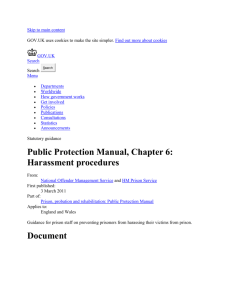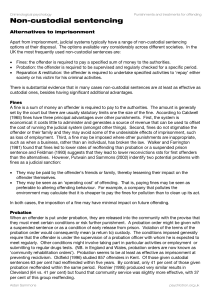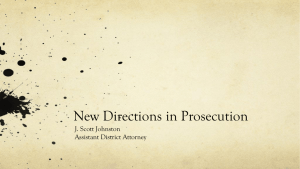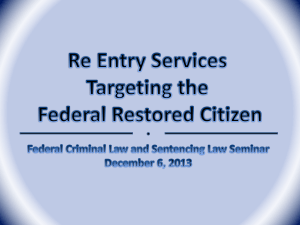Alternatives to imprisonment
advertisement
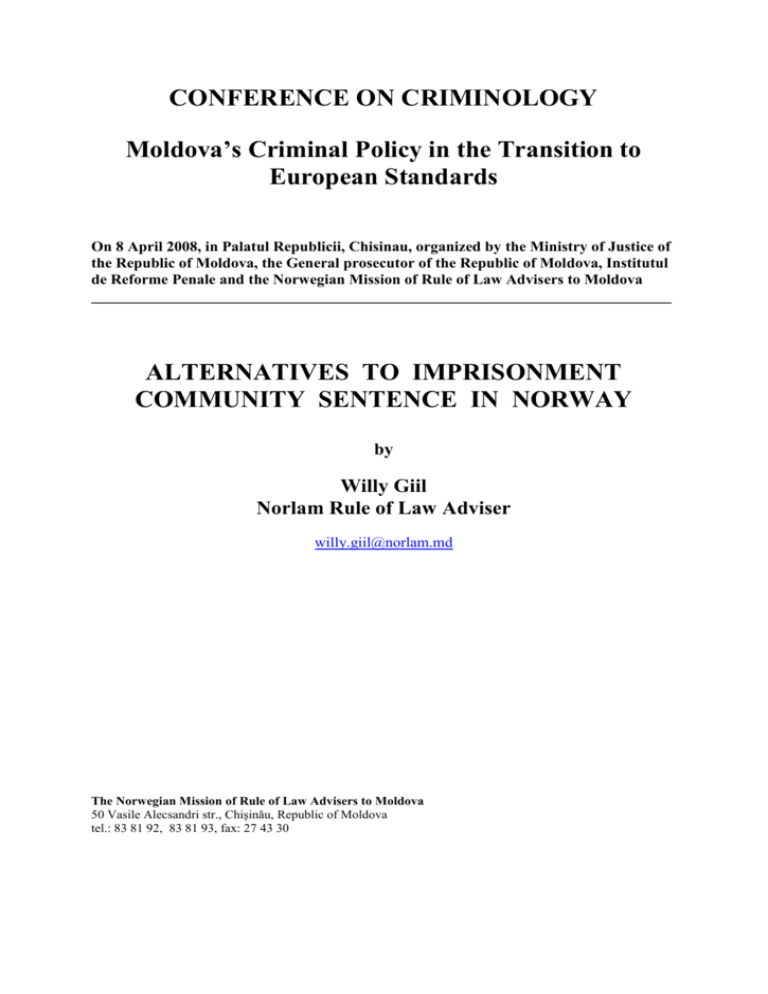
CONFERENCE ON CRIMINOLOGY Moldova’s Criminal Policy in the Transition to European Standards On 8 April 2008, in Palatul Republicii, Chisinau, organized by the Ministry of Justice of the Republic of Moldova, the General prosecutor of the Republic of Moldova, Institutul de Reforme Penale and the Norwegian Mission of Rule of Law Advisers to Moldova ___________________________________________________________________________ ALTERNATIVES TO IMPRISONMENT COMMUNITY SENTENCE IN NORWAY by Willy Giil Norlam Rule of Law Adviser willy.giil@norlam.md The Norwegian Mission of Rule of Law Advisers to Moldova 50 Vasile Alecsandri str., Chişinău, Republic of Moldova tel.: 83 81 92, 83 81 93, fax: 27 43 30 1. Introduction My name is Willy Giil and I am a Head of Probation Office in Norway. First of all I would like to say that I am very glad that I have got the opportunity to enter your country at this stage of the process when you are building up the Probation Service and implementing alternative to imprisonment. I have been working within the Probation System for 27 years. All these years in the system have given me a great experience and knowledge about the Probation system, how to manage offenders, implementing new alternatives to imprisonment, good practise and building up the organisation. I will give you a briefly overview of how community sentence developed in Norway. I will also focus on the benefits of imposing a community sentence rather then a short sentence of imprisonment. But first – a starting point: My opinion is that no offenders should be sent to prison unless the offending is so serious that no alternative sanctions are appropriate. And when they are sent to prison, they must be sent for no longer then their offending requires. It is important that offenders are properly punished for their crimes. But prison is not the only way of punishing them. We should use punishments that give us the best opportunities to address issues that might make someone less likely to re-offend. I would contend that a long, well-prepared community sentence is a better option to prevent new crime than a short prison sentence. Short prison sentences will in general not be followed up by any types of rehabilitation during the stay in prison and they therefore do not tackle the underlying factors of the offending behaviour. 2. Community sentence in Norway When I started in the Probation in 1980 we were at the same stage of the process as you are now. Norway had just started to build up a new Probation organisation. Probation was established as an independent service within the Ministry of Justice. For the very first time Community service was introduced as a new sanction. Community service was adopted from England where it had been an alternative to imprisonment since 1970. The idea was that the offender within his local community should pay back for the crime and harm he had committed. The offender was required to give up some of his free time to undertake unpaid work for the benefit of the local community and at the same time the offender could continue his work, education, contact with family and friends. Unpaid work was designed to teach the offender pro-socoal attitudes and behaviour. The skills and experience gained by the offender when he carried out unpaid work, should hopefully lead them to find paid employment. 2 The success of this type of sentence in England has had a remarkable impact on developing community service in Norway. In the first years we follow the English practise, but after some time we developed our own system as regards to legislation, guidelines and way of thinking. However, the key components were based on the English practise. The 1990`s were a decade of great changes. The seed of a more modern Probation service were sown. An evaluation of community service concluded that some important changes were required: Rules of procedure were lacking. Breaches should be dealt more firmly and consistently. Community service was only based on one activity – unpaid work. This provided no flexibilities. Research had showed that if we paid attention to other activities, such as employment, treatment, housing, life skills - the chances of rehabilitation and preventing crime would increase. Community service needed more public confidence. At the same time a closer link between the Probation and Prison service became in focus and subjects like “what works”, assessment of need and risk, cognitive programs, the role of the probation officer enter the stage. Changes continued into the new millennium and in 2001 we established the Norwegian Correctional Service that combines both prison and probation. The new Execution of Sentences Act was implemented in 2002. Community service was reorganized and renamed to Community sentencepunishment. Community sentence became more effective, but also more demanding. Longer prison sentences were converted into a community sentence order. The aspects of punishment and rehabilitation became more in balance. This was necessary to bring the sentence more in line with public opinion and to maintain public confidence. Community sentence is a major sentence, an alternative to imprisonment. The sentence represents something new compared to alternative sanctions used in the rest of Europe: The Probation service is given the authority to make the necessary decisions during the execution of the sentence at the local level. In each particular case the probation service determines the precise content of the sentence. There are three types of punishments that may be given separately or in combination: 1. Community service – that is unpaid work. 2. Participation in cognitive skills programs. 3. Other measures that is suitable for preventing crime. 3 The range of options is very wide and allows lot more flexibility in how different elements of a sentence can be combined. This implies that we may design an individual sentence and choose specific tools that we think will work best for each offender. A long community sentence gives us enough time to work on the offender’s motivation, problems, way of thinking and practical issues. Community sentence is based on three pillars: Punishment – Reparation – Rehabilitation. This is the only sentence that incorporate all three notions and the balance between the three principles is considerable important. 3. Punishment (the aspects of punishment) Many people have historically viewed prison as the only real sanction. The low trust in community sentences and the lack of understanding about the advantage of alternative sanctions have not only been a problem for people in general, but also within the criminal justice system. Because of this, many countries tend to adapt new sanctions as alternative to imprisonment, just to make the penal element clear and visible. Community sentence is not a way of avoiding punishment, but the offenders are being punished in another way. Community sentence includes a broad range of strict requirements and a proper planned and resourced community sentence, is a hardship for the offender, it is not a soft option. 4. Reparation (the aspects of reparation) Crimes are committed in the community, it is the community that suffer from the crime and deserve reparation. There must be a public confidence that the punishment fits the crime and that the offender will pay back for the harm and damage his offending has caused. The society will be pleased when the offender is being punished and that the retributive element is being satisfied. Community sentence provides a visible demonstration of reparation to the community. It is important that the public recognises the value of the work undertaken by the offender. In my opinion all unpaid work should be made visible. However, in some countries there is a trend of public shaming. I think that depends on culture and the how the society looks at people that have committed a crime. This can be a dilemma. On one hand it is important that offenders are not exposed to public shaming. But on the other hand the work should be visible for the public, since this is one of the most important success factors in building up public confidence. 5. Rehabilitation The most effective way of helping offenders to change their criminal behaviour, is to address the factors that contribute to their offending. Usually that is: lack of employment, education, life skills, housing, mentally illness, alcohol an drug problems. In Norway we have 4 several kind of rehabilitative programs that can effectively help offenders reduce their offending and even completely desist from crime. Researced has shown that these programs are more effective when they are delivered as a part of a community sentence. Because, in the community the offenders can test themselves in the midst of the reality of daily life. 6. Costs Community sentence in Norway has been a success and a positive alternative to imprisonment. Since 2002 community sentence orders have increased from 380 to over 4000 last year. Over 80% have fulfilled the sentence without re-offending or any breaches. The potential to achieve rehabilitation and to prevent re-offending are therefore significant. When I started in the system, the probation officers should “advice, assist and befriend” offenders. To day the core function is protecting the public and enforcement. In such times when the penal element is more in focus, when new methods of control are implemented, it is important that Probation tasks are in line with Human Rights. 8. Finally some words on Moldova.. When we are introducing a new sentence we all want it to be a success and that the sentence is trustworthy for the judges, the prosecutors and for the public in general. I have been so lucky to visit several probation offices since I came to Moldova last year. I have met many high qualified and engaged staff and seen how they are working. And I am really impressed. A lot of improvements have already been done. Just the fact that Moldova recently have employed over hundred new Probation officers, marks a significant step forward. Moldova is moving in the right direction, but still more can be done to fulfil the potential of the Probation service. In my opinion, these are some of the factors that will have impact on a further success: First of all the Probation service needs appropriate resources National guidelines are important. These must be clearly stated and enforced Training the staff. Their qualification, motivation and well-being will always be the best support and guaranty for progress and success Meaningful and valuable unpaid work must be provided Start with projects that Probation can manage with a high degree of success Success stories must be published. That will build public confidence Prosecutors, judges and lawyers must have more information of community sentences Co-operation with public agencies and voluntary organization The Probation Service`s contribution to the penal system is of decisive importance. Experience from Norway and many other European countries shows that the more independent the service is, the more it will increase its impact. In addition to community 5 sentence, they also write pre-sentence reports, work in court, work in prison, conditional release, with other agencies, with public protection and many other tasks. The outcome will be less crime, fewer victims and a safer society. 6
